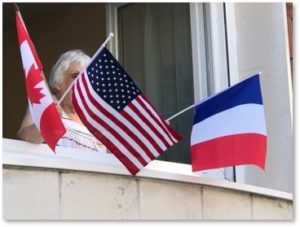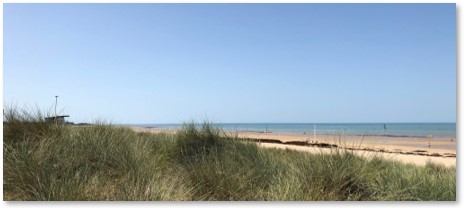Today is Independence Day, our nation’s birthday. On this day in 1776 the 13 colonies announced their intention to separate from England and become an independent country. To many American’s, celebrating Independence Day means swimming, hot dogs and fireworks. But America has a different meaning in other places.
The View from France
A week ago, my husband and I traveled through France on the second half of the Viking River Cruise called France’s Finest. Despite a heat wave for which France’s AC is not really equipped—we enjoyed our selves. On a banner day we drove up to the Normandy Beaches.
This eye-opening excursion brought World War II close to home. Here in the United States, we learn the history of World War II but the only part fought on American soil was the Japanese bombing of Pearl Harbor. Terrible fighting took place in Europe; while French civilians suffered from the Nazi occupation. Despite the best efforts of the Allies, the fight for freedom did not go well. In 1941 the United States, entered the war.
A More Immediate Memory
 In France things, that war had a great deal more impact. We started to feel this even further south in the village of Vernon. While walking through on a tour of the village, when old woman opened the window of her home on the second floor. Clutching three flags in her hands, she leaned out and began to wave them. She smiled broadly as she flew the French Tricouleur, the British Union Jack and the American Stars and Stripes.
In France things, that war had a great deal more impact. We started to feel this even further south in the village of Vernon. While walking through on a tour of the village, when old woman opened the window of her home on the second floor. Clutching three flags in her hands, she leaned out and began to wave them. She smiled broadly as she flew the French Tricouleur, the British Union Jack and the American Stars and Stripes.
Our guide told us the story: she had married a Canadian soldier but he died in World War II. The woman wanted to express her gratitude to the people of Canada and the United States for liberating the French. She held this small demonstration every time an American or Canadian tour group walked past. Many people took her picture but I had a lump in my throat. My husband took this one, which I use without compromising her privacy because most of her face is obscured.
The Normandy Beach Experience
Our trip to the Normandy Beaches intensified that experience. Viking gave us a choice of two excursions: One went to the beaches, like Omaha, where the Americans landed and to the American cemetery. Another gave us the opportunity to see the Bayeux Tapestry and the Canadian/ Australian beaches. I really wanted to see the Bayeux Tapestry so I chose that one. I was not disappointed.
After a morning of art and Medieval history in Bayeux, we headed out to Juno Beach and the Canadian Juno Beach Centre, which is staffed by articulate young people from Canada. Our stay started with an audio-visual presentation in a room shaped like a landing craft with planes flying overhead and other boats surging toward the beach on both sides.
The museum was filled with artifacts from the D-Day invasion and a film about the young Canadians—volunteers all—who trained in England for three years to join the assault on the German guns. It ended with a young family walking along today’s beach while the ghosts of those vanished men walked behind them. It created another lump and tears along with it.
As we drove out along the coast, however, I could easily imagine the Allied troops storming the beach, attacking the German bunkers and pushing through the fields toward their targets of Bayeux, Carentan, St. Lô, Caen and other French cities. The fields and many of the German bunkers are still there.
Finding Relatives from Juno Beach
We traveled to the Canadian cemetery, located in a field that had been donated for this purpose by a French farmer to honor the fallen. It was beautiful, immaculate, serene and moving. I looked through the book of those who had been interred and found two with my family name. I located both graves and took photos of their headstones.
We finished with a stop at the “Pegasus Bridge,” taken by men flying incredibly fragile Horsa Gliders” who landed next to the critical bridge and fought to control it. The bridge had been replaced and the original moved to the back of the museum’s property alongside a model of one of the Horsa Gliders. I had never heard of them before and marveled that anyone would be brave enough to fly an aircraft made of balsa wood and canvas.
At the British cemetery, others got out to find their own ancestors who had given their lives to defend freedom and democracy.
Beyond Textbook History
All of which led me to an understanding of how much the people of France suffered during the war and the German occupation. This is not just textbook history for them: they lived it and the memory of that awful time is much closer to surface there than it is here.
One good way to honor American’s birthday is to watch movies like Saving Private Ryan with its harrowing depiction of the landing on Normandy’s beaches—one of the most accurate depictions of war ever filmed. The Longest Day shows the liberation of the Pegasus Bridge, albeit somewhat romanticized, with the Horsa Gliders.
Then be thankful that the Germans never invaded us, that we never had to placate a hostile foreign power, that we never had one man with the power to exterminate millions, terrorize millions more, and destroy whole cities in the process.
Happy birthday, America!


